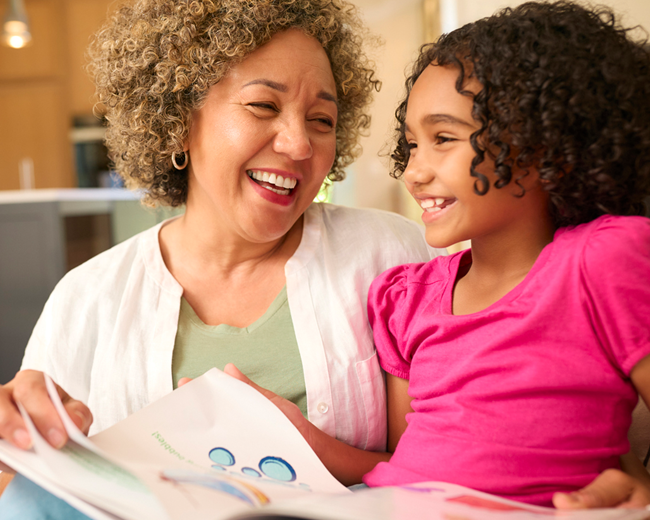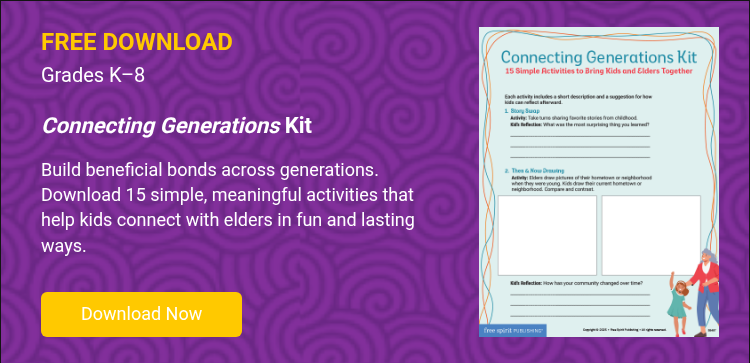Strong relationships between children and elders can nurture emotional growth, expand worldviews, and build resilience. In this article, you'll discover the many ways that intergenerational relationships positively impact children's social and emotional development—and get actionable ideas for how to foster these connections in your classroom, home, or community.
The Value of Intergenerational Relationships in a Child’s Life
As an educator, I’ve often witnessed students in the care of grandparents, other relatives, and family friends and neighbors. For some families, these arrangements are born out of challenging times. For others, they are the cultural norm. Regardless of how intergenerational relationships spring into being, it is important to highlight the opportunities and benefits these relationships can bring to kids.
Cultural and Emotional Connection
Intergenerational relationships support kids in a number of ways. Interacting with elders can connect young people to their families, communities, and cultures. In many cultures, intergenerational relationships are essential facets of the culture that have sometimes been ruptured—through migration, immigration, historical trauma, and social injustice. Developing a relationship with an elder can connect children to beliefs, language, rituals, and other activities in their culture that can imbue a sense of belonging and pride.
Building Resilience and Perspective
Researcher Carmella B. Kahn and team find that connections with elders can instill resilience. Children learn about the strength of elders and the challenging experiences they may have had, which can help them tap or cultivate their own well of strength to handle challenges in a positive way.
Intergenerational relationships can offer young people perspectives that expand their worldviews. Connecting with elders can help kids see the future in a positive light and be unafraid of aging.
Developing Self-Esteem Through Connection
Kids can feel appreciated and loved when involved in intergenerational relationships. Through helping or working in partnership with an elder, kids gain self-esteem, knowing that they are contributing in some way.
Ways to Foster Intergenerational Relationships

There are a number of ways you can help foster intergenerational relationships. Start by asking:
- How can I include stories reflecting both kids and elders in our communities?
- How can I encourage community elders to share their knowledge and experience?
- How can we prioritize relationship building between kids and elders?
- How can I highlight the value that intergenerational relationships offer to both kids and elders?
Highlighting Mutual Benefits
It is also important to highlight to elders the mutually beneficial nature of the relationship. For example, a young child can be more physically powerful or have comparatively adept motor skills compared to an aged companion and can be helpful with physical tasks. For elders, relationships with youth can:
- validate the importance of their knowledge and experience
- connect them with the affection and energy of young people, which can reinvigorate their spirits
- provide meaningful and fulfilling activities that promote self-worth
- keep them more physically engaged
- keep them more socially connected, which helps boost the immune system.
Activities That Strengthen Intergenerational Relationships
Sharing stories that model intergenerational relationships is another way to foster them. These stories can provide an entry point for discussion and validate relationships that children may already have.
Storytelling and Conversation Starters
When sharing stories, ask questions that focus on connection and commonality. Ask kids what activities they do with an elder in their life or what they would like to do. Ask them how they help or what they could contribute. Have them imagine what they will be like when they are older.
Shared Activities to Encourage Bonding
Providing opportunities for kids and elders to share activities is another way to foster the support that intergenerational relationships can bring. Recognizing how some elders interact with young people can also validate and encourage greater participation. Excellent activities to share include:
- cooking and/or baking, which can connect to foodways
- interviewing each other about favorite toys, games, plants, or animals
- story reading or storytelling
- gardening, whether tending to houseplants in pots or growing vegetables outdoors
- singing, dancing, or playing instruments together
- hair styling/braiding
- making or doing something in service together to benefit others in the community
- writing a story together—take turns orally at first, then write it down (the elder can write while the child draws)
- fishing, hunting, and foraging
- knitting, sewing, carving, or other handcrafts
- sharing old photos
Honoring Cultural Differences in Intergenerational Relationships
It is important to recognize that intergenerational relationships may look different across cultures. Respect families who have different experiences, some of which might not include the same formal education. They may not speak the same language or put the same emphasis on the written word if they come from oral cultures where storytelling is still central.
Final Thoughts: Start Small, Start Now
The stories I hear from my students tell me that kids yearn for connection with elders and enjoy the moments that they are able to share with those who are in their lives. Highlighting existing relationships with intention and promoting ways to form new partnerships can only benefit our young people in a time when connection is key.
Whether it’s sharing a story, planting a seed, or inviting a grandparent into the classroom, small actions can make a big impact. Use the ideas in this article to start building or strengthening intergenerational relationships in your own sphere today.
Freedman, Marc. “What Happens When Old and Young Connect.” Greater Good Magazine, April 22, 2019.
Kahn, Carmella B., et al. “American Indian Elders’ Resilience: Sources of Strength for Building a Healthy Future for Youth.” American Indian and Alaska Native Mental Health Research 23, no. 3 (2016): 117–133.

